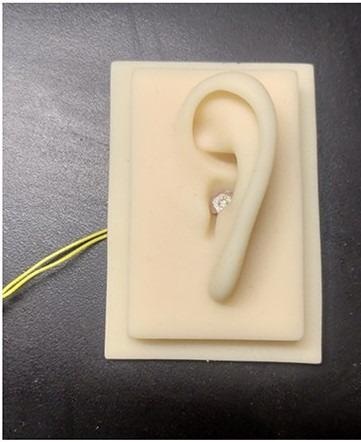In several instances, the tiny hairs present in the cochlea of the inner ear that enable the brain to identify electrical pulses as sounds are broken. This can lead to hearing loss. As a measure taken toward a sophisticated artificial cochlea, scientists in the ACS Nano journal describe a conductive membrane, which has the ability to translate sound waves into matching electrical signals while being implanted within a model ear. This needs no external power.
 An electrically conductive membrane implanted inside a model ear simulates cochlear hairs by converting sound waves into electrical pulses; wiring connects the prototype to a device that collects the output current signal—image Credit: Adapted from ACS Nano 2021; doi.org/10.1021/acsnano.1c04242.
An electrically conductive membrane implanted inside a model ear simulates cochlear hairs by converting sound waves into electrical pulses; wiring connects the prototype to a device that collects the output current signal—image Credit: Adapted from ACS Nano 2021; doi.org/10.1021/acsnano.1c04242.
While the functioning of hair cells present inside the inner ear stop, there is no way to revoke the damage. At present, treatment is confined to cochlear implants or hearing aids. However, such devices need external power sources and can have trouble amplifying speech appropriately so that it is comprehended by the user.
One potential solution is to simulate healthy cochlear hairs, transforming noise into the electrical signals processed by the brain as noticeable sounds. To achieve this, previous scientists have attempted to use self-powered piezoelectric materials, which get charged when they are compressed by the pressure that follows sound waves, and triboelectric materials, which generate friction and static electricity when moved by such waves.
But the devices are not simple to make and do not generate sufficient signals throughout the frequencies included in human speech. Hence, Yunming Wang and collaborators wished for an easy method to fabricate a material that utilized both friction and compression for an acoustic sensing device with high sensitivity and efficiency throughout a wide range of audio frequencies.
To make a piezo-triboelectric material, the scientists blended barium titanate nanoparticles coated with silicon dioxide into a conductive polymer, which they dried into a thin, flexible film. They eliminated the silicon dioxide shells with an alkaline solution.
This step left out a sponge-like membrane with spaces near the nanoparticles, enabling them to jostle about when hit by sound waves. In tests, the scientists demonstrated that contact between the nanoparticles and polymer raised the electrical output of the membrane by 55% compared to the pristine polymer.
When the membrane was wedged between two thin metal grids, the acoustic sensing device generated an optimum electrical signal at 170 Hz, a frequency within the range of the majority of the adult’s voices. Ultimately, the scientists implanted the device within a model ear and played a music file.
The electrical output was recorded by the researchers and converted into a new audio file, which exhibited a strong similarity to the original version. The scientists say their self-powered device is sensitive to the extensive acoustic range required to hear most sounds and voices.
The researchers acknowledge financial support from the General Program of the National Natural Science Foundation of China, the Fundamental Research Funds for the Central Universities, and the Double First-Class-Independent Innovation-Subject Construction.
Journal Reference:
Zheng, J., et al. (2021) Acoustic Core–Shell Resonance Harvester for Application of Artificial Cochlea Based on the Piezo-Triboelectric Effect. ACS Nano. doi.org/10.1021/acsnano.1c04242.